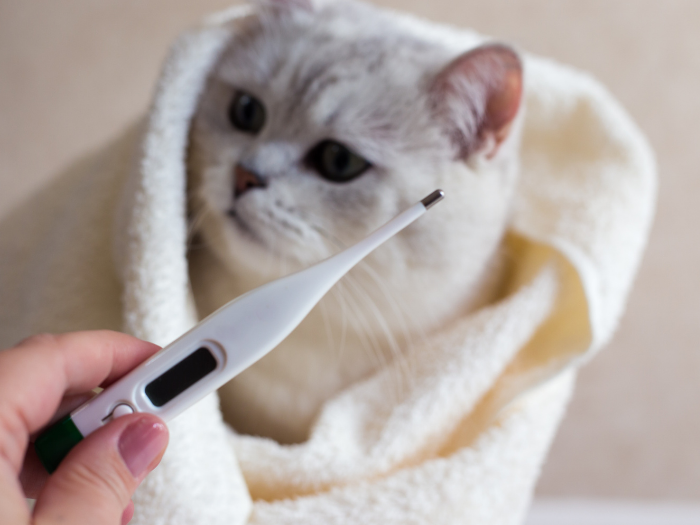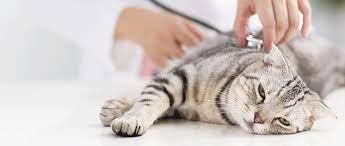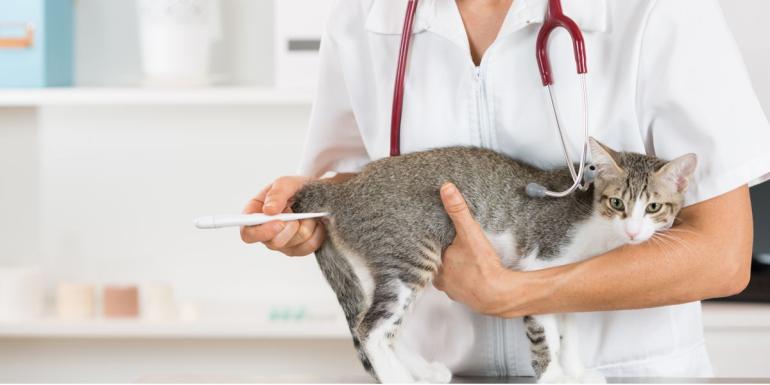Cat Fever - is it serious? Understanding Causes, Symptoms, and Care

Just like humans, cats can develop a fever due to various underlying causes. In this article, we will explore the causes, symptoms, and appropriate care for cat fever, helping cat parents understand this condition and respond effectively.
Fever - is it serious?
Your cat often feels warm to the touch, especially when you touch a bare area of skin. This is because a cat's body temperature is often greater than a person's. The range of body temperature is quite small, ranging from 38.1ºC (100.5ºF) to 39.2ºC (102.2ºF), with minimal variations during the day. The morning and evening tend to record the lowest and highest temperatures, respectively. In cats, a fever is merely a rise in body temperature and can be associated with a variety of conditions.

How is body temperature controlled?
Even when the cat is subjected to significant variations in the outside temperature, its body temperature remains constant. Specialized receptors called thermoreceptors measure any changes in body temperature. The body organs that have the ability to produce or lose heat are alerted by these detectors. An increase in body temperature causes the cat's skin to perspire more blood, which loses heat as it moves closer to the surface. The cat will look for a cool spot to lay while it's hot outside. Cats shiver in chilly environments because their muscles produce more heat, so they curl up into a ball and their haircoat stands up to trap warm air against their skin.
Can a fever hurt my cat?
A fever is a sign of trouble because a normal cat's body temperature is so carefully regulated. There are certain illnesses that cause brief fever "spikes," in which the body temperature rises sharply for a brief while before falling back to normal and rising again later. Other illnesses result in a constant fever that is higher than usual. A cat with a fever is normally sad and may not want to eat, but a mild fever that lasts for a short while does not harm the body in any way. It's critical to attempt lowering body temperature if fever reaches dangerously high levels (over 41ºC). Fans and cool water can help dampen the coat, but you should seek veterinarian advice right away. Thankfully, elevated body temperatures are quite uncommon and are typically caused by heat stroke or severe seizures, rather than infections.

Why do fevers occur?
'Pyrogens', or compounds that alter the equilibrium of the body temperature, are the cause of fever. The animal now attempts to maintain a greater body temperature after resetting its "normal" temperature. Pyrogens are compounds that the body releases naturally in reaction to inflammation, including bacteria, viruses, toxins, and some medications. Raising the body temperature helps the cat have a better chance of fighting off the infection, since germs may not multiply as quickly at higher temperatures. In many circumstances, a little fever might even be beneficial. It is usually advisable to attempt treating the underlying cause of a fever rather than suppressing it without first attempting to determine what is causing it.
Causes of Cat Fever
Fever in cats can be a result of several factors, such as:
-
Infections: Bacterial, viral, or fungal infections can trigger a fever response in a cat's body.
-
Inflammatory Disorders: Conditions like arthritis or inflammatory bowel disease can lead to a fever.
-
Foreign Bodies: Ingestion of foreign objects that cause internal irritation or blockages can induce a fever.
-
Immunizations: Some cats might develop a mild fever after receiving vaccinations. This usually subsides within a day or two.
-
Heatstroke: Cats exposed to excessive heat without proper hydration and ventilation can suffer from heatstroke, leading to an elevated body temperature.
How can I tell if my cat has a fever?
You can confirm whether your cat has a fever by taking their temperature if you have any suspicions. Although digital thermometers are quite dependable and easy to use, cats frequently object to having their temperatures taken. Your cat could allow you to take their temperature if they are extremely quiet; if not, you should ask your veterinarian to do it for you. If your cat's temperature is elevated, check it again in a few hours. Get in touch with your veterinarian if the temperature consistently rises beyond 40ºC or is higher than usual. If the thermometer is inadvertently placed into feces in the rectum, it can occasionally record a falsely low temperature reading. If you suspect this, take another look at the temperature after your cat has recently passed a motion.
Symptoms of Cat Fever
Identifying the symptoms of fever in cats is crucial for early detection and treatment. Common signs include:
-
Lethargy: Cats with fever tend to be unusually tired and lack energy.
-
Loss of Appetite: A feverish cat might lose interest in food and water.
-
Warm Ears and Paws: Increased body temperature can cause the ears and paw pads to feel warmer than usual.
-
Shivering: Some cats with fever may shiver or tremble due to fluctuations in body temperature.
-
Decreased Grooming: Cats often groom less when they are unwell, including having a fever.

What can my vet do to help my cat?
The majority of feline fevers are brought on by infections of some form (often an abscess from a cat bite). Usually, the body temperature returns to normal on its own or with the use of drugs to manage the infection. When a fever lasts for an extended period of time and no clear reason for the elevated temperature is discovered, even using basic diagnostic procedures, the condition is referred to as "Fever of unknown origin," or FUO. There are numerous illnesses where a temperature is the only unusual symptom.
Your veterinarian might want to do more tests to try and determine the root of the issue if your cat's temperature doesn't go down after a few days of medication. Blood tests, X-rays, and ultrasounds are typically necessary for the investigation of an unexplained fever, but many further tests can also be required.
To confirm or rule out a certain diagnosis, several tests will need to be run multiple times. Regretfully, the process of investigating a medical condition might take many weeks, incur significant expenses, and there is no assurance that a precise diagnosis will be made. Even though the diagnosis is unknown, it might be possible to take drugs to lower the fever once certain disorders have been ruled off of the list.
Never give medications to your cat without veterinary advice because you may mask the signs of a more serious disease and make it harder for your vet to find out what is going on, and many commonly used human drugs (such as paracetamol) are extremely toxic to cats. In some cats with unexplained fever the fever may resolve without treatment but may then recur months or years later, again with no apparent cause.
Care and Treatment
Treatment for cat fever depends on the underlying cause:
-
Antibiotics or Antiviral Medications: If the fever is due to an infection, the vet may prescribe antibiotics or antiviral medications to combat the underlying issue.
-
Fluid Therapy: Cats with fever are at risk of dehydration. The vet might administer fluids to keep the cat hydrated and help regulate body temperature.
-
Fever-Reducing Medications: In some cases, the vet may recommend fever reducers to make the cat more comfortable. However, it's crucial never to administer human medications without veterinary guidance, as some can be toxic to cats.
-
Rest and Comfort: Provide a quiet, comfortable environment for your cat to rest and recover. Ensure they have access to fresh water and a clean litter box.
How to take your cat's temperature

- Turn on the thermometer (usually by pressing the button on the side)
- Dip the end of the thermometer into vasoline or similar lubricant
- Lift your cat's tail gently and slowly insert the thermometer into the rectum
- Keep the thermometer in place until a steady temperature reading is recorded (most digital thermometers will automatically 'bleep' when temperature has been recorded
- Remove the thermometer and read the temperature displayed in the small window
- Turn off the thermometer and wipe clean before storage
- Record the time and date that the temperature was recorded.
Cat fever, while alarming, can be managed effectively with prompt veterinary care and attention. As a responsible pet owner, being vigilant about your cat's health, recognizing the signs of fever, and seeking timely medical assistance can contribute significantly to your feline friend's speedy recovery. With the right care and affection, your cat can bounce back to their playful, healthy self.


